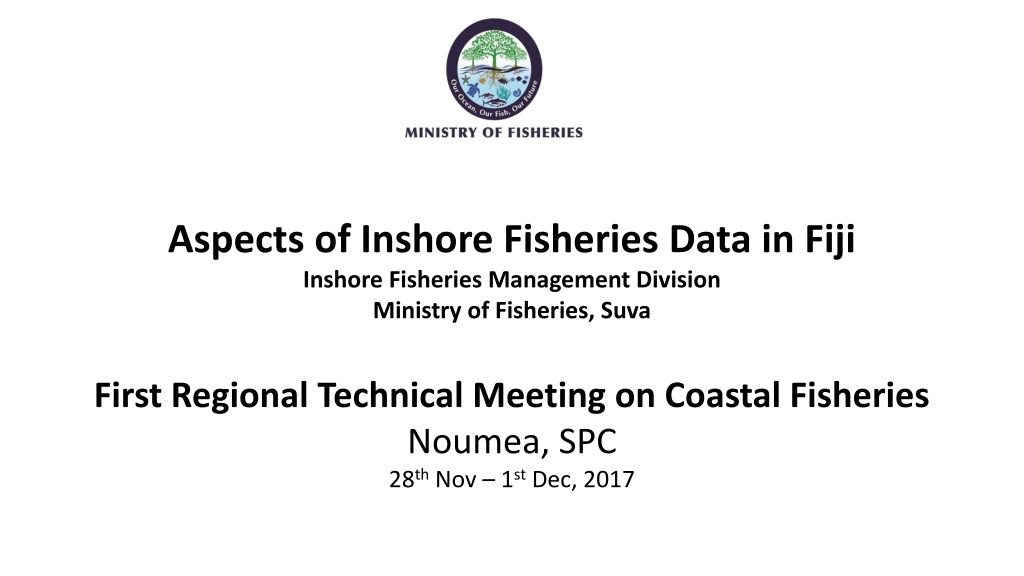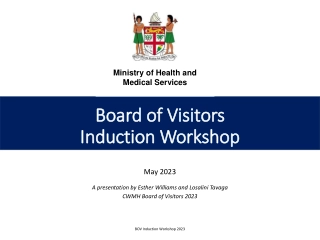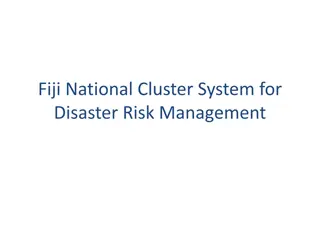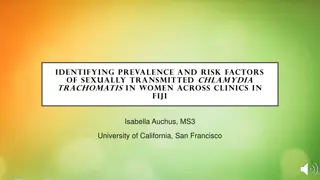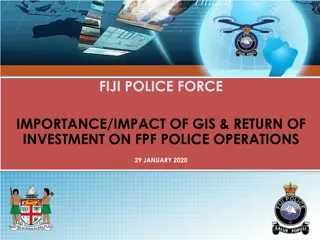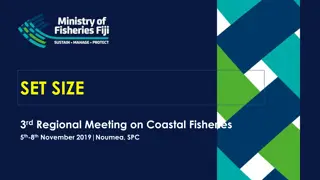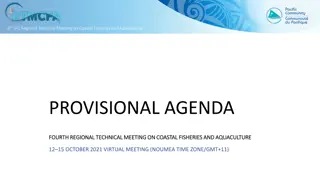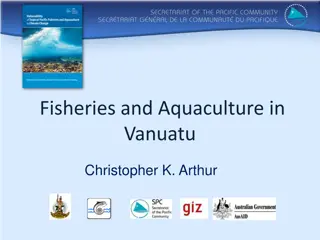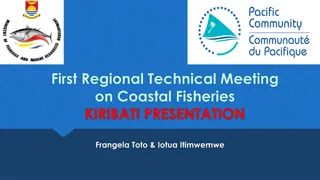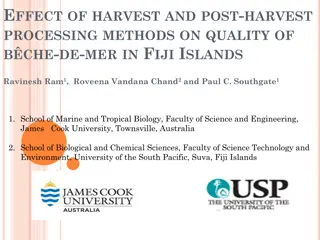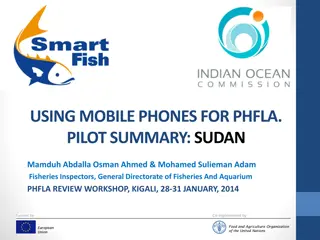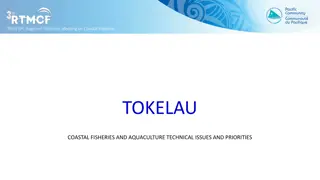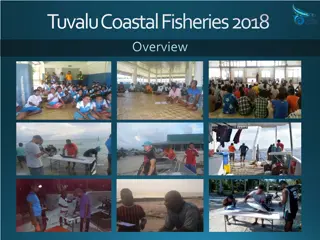Insight into Fiji's Inshore Fisheries Data
This content sheds light on the data collection methods and processes for inshore fisheries in Fiji. It covers aspects such as market surveys, export data, and monitoring practices. The information provides valuable insights into the management of coastal fisheries in the region, highlighting key observations and challenges faced in the collection and analysis of fisheries data.
Download Presentation

Please find below an Image/Link to download the presentation.
The content on the website is provided AS IS for your information and personal use only. It may not be sold, licensed, or shared on other websites without obtaining consent from the author.If you encounter any issues during the download, it is possible that the publisher has removed the file from their server.
You are allowed to download the files provided on this website for personal or commercial use, subject to the condition that they are used lawfully. All files are the property of their respective owners.
The content on the website is provided AS IS for your information and personal use only. It may not be sold, licensed, or shared on other websites without obtaining consent from the author.
E N D
Presentation Transcript
Aspects of Inshore Fisheries Data in Fiji Inshore Fisheries Management Division Ministry of Fisheries, Suva First Regional Technical Meeting on Coastal Fisheries Noumea, SPC 28thNov 1stDec, 2017
The Current Data Being Collected on Inshore Fisheries The Market Survey for sales of the production of commercial inshore fisheries A permit system of the Ministry of Fisheries for determining the value/volume of exports from inshore fisheries Monitoring of exports by the Fiji Revenue and Customs Service Collection of various types of data at the community level by the Ministry s Marine Resource Inventory Survey Information on licensed inshore fishers and their activities
The Market Survey: In 1977 the Fisheries Division starting collecting species composition at four locations near Suva: Suva Market, Nausori Market, Nasinu roadside, and Suva/Nausori Hotels and shops. This sampling was expanded a few years later. The output of the survey is the species, length, weight, value, and mean price of finfish and shellfish that are sold in the country. In recent years some problems have developed, mostly due to funding cut-backs and methodology used and consistency in the 4 geographic divisions of the country Evolved into excel data inputs from Division and submitted to HQ In 1985 Jon Cook was employed by FAO to review the Market Survey. He will review the system again in Feb 2018. mainly involve diverging
Fishery Export Data: Using powers of the Offshore Fisheries Management Regulations 2014, a permit for exports (including exports from inshore fisheries) issued by the Ministry of Fisheries is required as part of the regular export process of the Fiji Revenue and Customs Service. Ideally, each inspection leads to a permit for export and the species & quantities from each permit are entered into a database. The process of issuing permits for exports and the maintaining of the export database is presently handled by the Offshore Fisheries Division (inshore fish,aquaculture,cites regulated species,aquarium).
Monitoring exports by Fiji Revenue and Customs Service: Fiji keeps track of exports (including fishery exports) using the international harmonised system of tariff codes (HS system). Historically, the Ministry of Fisheries publishes HS fishery export information in its annual reports. For fishery purposes,there are two difficulties with the HS system: 1. The system can be quite imprecise. For example, HS0304 is fish fillets and other fish meat (whether or not minced), fresh chilled or frozen so it is not possible to determine whether a particular HS0304 commodity is from coastal fisheries, offshore fisheries,or aquaculture. 2. The inspection is not done by people with fisheries experience and some errors of classification exist. For example, during many years the data show that other salmonids are a major export of Fiji.
Collection of various types of data at the community level by the Ministry s Marine Resource Inventory Survey: Resource surveys have been undertaken by the Ministry to determine the fishery resource status of each of traditional fishing area to assist in the development of management plans. The surveys have included underwater visual census,gillnetting,reef transect sampling and socio-economic evaluations. The surveys have been operating for 15 years and about half of the 410 of traditional fishing areas in Fiji have been surveyed. The survey now has a complement of 24 staff in two survey teams,with funding of around US$250,000 annually in recent years. A major challenge is to analyse the large amount of data collected and report on it to the communities in a timely manner.
Information on licensed inshore fishers: Data on inshore fisheries licencing and related activities are important for fisheries management. In addition to data on the fishers, fishermen are required to return monthly reports of their catch per fishing area. Ideally, the Ministry of Fisheries can determine what is the total weight of fish caught per species in each fishing area,with which fishing method and time spent fishing. The analysis of the catch data has been challenging. In Feb 2017 SPC assisted in the improving the database to make extractions simpler.
Challenges Consistency Collecting data on a regular and uniform basis Data validity (variations in dates),Forms not filled out by fishermen etc. Resources Having the right tools and consistent (human)resources to collect the necessary data on a systematic manner Methodology Having a standard a single standard of collecting data across the division and points of access for catch,licensing information Collecting the right type of data that is again uniform and consistent across all points of data collection and entry Storage Loss of Data Analysis Resources to analyze Updated and analyzed Real time data for briefings and decision making
For the Future: There is considerable interest in using SPC s Fisheries Friendly household income and expenditure survey (HIES) to obtain information on Fiji s small-scale fisheries. There have been HIES in Fiji in 2003, 2009, and 2014. There will be another HIES in Fiji in mid-2018 (hopefully it will be fisheries friendly ). Establishment of a New Inshore Fisheries Management Division for Fiji A review of the Market Survey will be carried out in February 2018. Reforms to the Marine Resource Inventory are underway and the Ministry is contemplating cleaning up its inshore fisheries export database. Fiji s National Development Plan (released November 2017) states: To ensure better management of coastal and inshore fisheries, a reliable data-gathering framework will be established to track the level of catch and fish stock on a regular basis. SPRWork (Northern &Western Provinces) Tails (SPC) (Ra & Kadavu)
